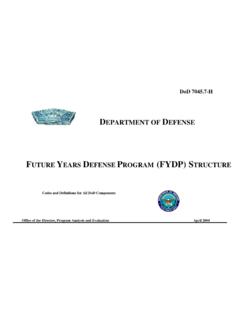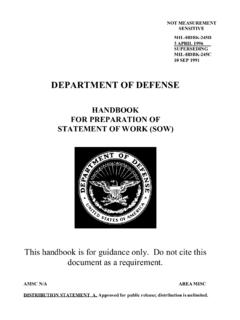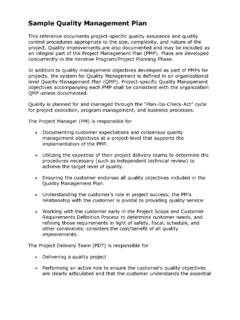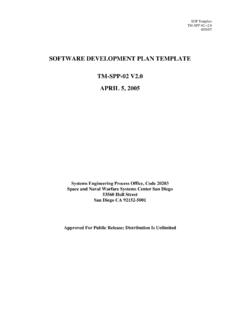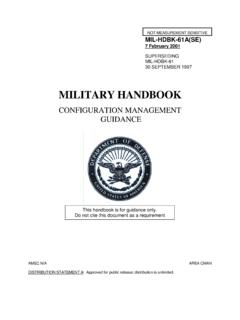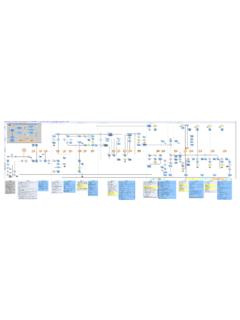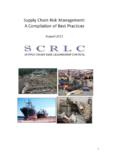Transcription of DoD Guide to IPPD - AcqNotes
1 DoD Guide to Integrated Product and Process Development (Version ). February 5, 1996. OFFICE OF THE UNDER SECRETARY OF DEFENSE. (ACQUISITION AND TECHNOLOGY). WASHINGTON, DC 20301-3000. DoD Guide to IPPD. _____. Page ii FOREWORD. Reform of the acquisition process is now a driving force in the Department of Defense. A number of specific acquisition reform initiatives have been conceived, some borrowed from industry, and briefed at the highest levels of Government. Many have been mandated by the Secretary of Defense, Dr. William Perry, implemented by the Under Secretary of Defense for Acquisition and Technology, Dr. Paul Kaminski, the Services, and some have been enacted by Congress. One such initiative borrowed from industry that will fundamentally change the way the Department does business is Integrated Product and Process Development (IPPD). IPPD is a widely defined management technique normally implemented by Integrated Product Teams (IPTs). IPPD is currently in growing use in many commercial and government organizations.
2 This Guide has been written to serve as a primer for the Defense Acquisition Workforce to foster, facilitate and understand the use of IPPD. It's focus is how industry implements IPPD and how this impacts the DoD's role in the acquisition process and the program office interfaces with their industrial counterparts. It is a non-directive living document that contains industry and government best practices acquired from a survey regarding IPPD implementation. This Guide is being developed in concert with the revised versions of DoD Directive and DoD Instruction and with The Rules of the Road A Guide for Leading Successful Integrated Product Teams. Through periodic updates, it will be kept consistent with the acquisition direction given in DoDI and OSD guidance publications, as well as other current approved acquisition practices. This Guide will also be included in the forthcoming DoD Acquisition Deskbook. Follow-on efforts will include a closer look at the use of tools, teams, and processes to be included in future editions and an accompanying IPPD Handbook.
3 This handbook will present IPPD. management practices in greater depth citing appropriate lessons learned and case studies. Suggestions for improving the Guide or potential case studies for the handbook are welcomed. Members of the defense acquisition community are encouraged to submit inputs. Comments and recommendations for improvement to the Guide can be forwarded to: OUSD(A&T)/DTSE&E;. ATTN: Mr. Mark D. Schaeffer, Deputy Director, Systems Engineering; 3110 Defense Pentagon;. Washington, DC 20301-3110. Telephone: Commercial: (703) 697-6329 or DSN 225-2300. E-mail: (Signed). John A. Burt Director, TSE&E. iii DoD Guide to IPPD. _____. Page iv DoD Guide to IPPD. Table of Contents Table of Contents ..v List of Figures ..vii Executive DoD Guide to Integrated Product and Process Development Chapter 1 IPPD Concept Introduction .. 1-1. Background .. 1-2. IPPD 1-3. IPPD Key Tenets .. 1-5. Integrated Product Teams (IPT).. 1-7. A Typical Industry Approach .. 1-8. Expected Benefits of 1-9.
4 Chapter 2 IPPD and DoD Acquisition Background .. 2-1. Acquisition 2-1. Variations of the Acquisition Process .. 2-3. OSD IPT 2-4. IPPD Tools .. 2-4. Development 2-8. Education and Training .. 2-9. Barriers to 2-10. Chapter 3 Management of IPPD in DoD Acquisitions Background .. 3-1. DoD's 3-1. Industry-DoD Team Relationship .. 3-4. Appendix 1 - Acronyms _____. Page v DoD Guide to IPPD. _____. Page vi DoD Guide to IPPD. List of Figures Figure Title Page 1-1 A Generic IPPD Iterative 1-2 Generic IPTs Implementation Process (Industry) ..1-8. 1-3 Traditional Serial Approach Versus 2-1 IPT Types, Focus and 3-1 Notional IPT _____. Page vii DoD Guide to IPPD. _____. Page viii DoD Guide to IPPD. Executive Summary The ultimate goal of DoD acquisition is to provide the warfighters with world-class equipments and systems at an affordable cost and on a schedule that is responsive to the need. Accordingly, the Secretary of Defense, William J. Perry directed on May 10, 1995, the immediate implementation of a management process called Integrated Product and Process Development (IPPD) throughout the acquisition process to the maximum extent practicable.
5 To expand upon the Secretary's memorandum and to outline an application of the IPPD process to the Acquisition System, this Guide has been prepared to assist the acquisition work force and the defense industry. It is non-directive and serves as only one tool in understanding this time-tested, proven, yet evolving process. At the core of IPPD implementation are Integrated Product Teams (IPTs) that organize for and accomplish, tasks that acquire goods and services. These multifunctional teams are the foundation of the process. The IPT decision-making processes and the empowerment of the teams may require cultural change in the way decisions are made in the Department. Results of a recent DoD survey show that where an IPPD process has been effectively implemented, the acquisition timeline has been shortened, and life-cycle costs have been reduced, while continuing to meet the warfighter's needs. This document is designed to provide a general understanding of the Department's perspective on IPPD.
6 It is intended to build upon the IPPD efforts underway within industry and government. DoD. Components are encouraged to use this Guide in the education of their acquisition work force and to tailor its contents as applicable to their particular acquisition programs. The contents of this Guide are organized into three chapters. Chapter 1 is a discussion of generic IPPD and IPT concepts, characteristics, and benefits normally found in industry. Chapter 2 outlines tools, techniques, and processes used in DoD and includes a list of barriers that organizations have encountered. Chapter 3 addresses the management of IPPD involving both DoD and supporting industry. This Guide borrows heavily from many industry and government sources. Additionally, this Guide incorporates suggestions from a recent DoD survey of government and industry that sought lessons learned and information on IPPD experiences. OSD implementation of IPTs and guidance regarding their formation and use is contained in the DoD Rules of the Road - A Guide for Leading Successful Integrated Product Teams (November 95).
7 It is the intent to continuously augment, update, and increase the utility of this Guide . As such, suggestions for its improvement are welcome. _____. Page ix DoD Guide to IPPD. _____. Page x DoD Guide to IPPD. Chapter 1 IPPD Concept Introduction ..I am directing a fundamental change in the way the Department acquires goods and services. The concepts of IPPD and IPTs shall be applied throughout the acquisition process to the maximum extent practicable.. from SECDEF Memo of 10 May 1995. The Department of Defense (DoD) has worked to find the best methods for reengineering its processes. Several studies have addressed the benefits of using Integrated Product and Process Development (IPPD). IPPD has been successfully used by the private sector and by the Services on selected programs to reduce product cost and to field products sooner. In Acquisition Reform: A Mandate for Change, the Secretary of Defense concluded, (DoD) must reduce the cost of the acquisition Process by the elimination of activities that, although being performed by many dedicated and hard-working personnel, are not necessary or cost effective in today's environment.
8 DoD must shift from an environment of regulation and enforcement to one of incentivized performance. The objective is to be receptive to ideas from the field to obtain buy-in and lasting change. IPPD has been mandated for the Department of Defense. IPPD is a management technique that simultaneously integrates all essential acquisition activities through the use of multidisciplinary teams to optimize the design, manufacturing, business, and supportability processes. At the core of IPPD implementation are Integrated Product Teams (IPTs) that organize for and accomplish tasks that acquire goods and services. These multifunctional teams are the foundation of the process. The IPT decision-making processes and the empowerment of the teams may require cultural change in the way decisions are made in the Department. The Under Secretary of Defense (Acquisition & Technology) has recently identified critical changes that must take place in DoD in order for successful IPTs to be formed.
9 He indicated that DoD must move away from a pattern of hierarchical decision making to a process where decisions are facilitated across organizational structures by IPTs. It means breaking down institutional barriers. It also means that our senior management staffs are in a receive mode - not just a transmit mode.. This Guide is a primer on IPPD. Nothing in this Guide should be construed as directive in nature. Any processes described are examples. Those processes actually used should be decided upon at the appropriate time by the implementing organization and tailored for each application. _____. Page 1-1. DoD Guide to IPPD. Background IPPD has its roots in integrated design and production practices, concurrent engineering, and total quality management. In the early 1980s, industry used the concept of integrated design as a way to improve global competitiveness. Industry's implementation of IPPD expanded concurrent engineering concepts to include all disciplines, not just technical, associated with the design, development, manufacture, distribution, support, and management of products and services.
10 Diverse segments of industry have successfully implemented this concept to become recognized leaders in IPPD practices, most notably in the auto and electronics industry. Many corporations have institutionalized the IPPD. process and associated training programs. Several of these corporations were consulted in the development of this Guide . Several government actions led to the Department of Defense (DoD) formally adopting IPPD. principles. These include: The Federal Acquisition Streamlining Act of 1994. Among other things, this legislation simplified acquisition of commercial items and allowed DoD to explore innovative acquisition procedures under DoD's statutory pilot program authority. Reengineering the Acquisition Oversight and Review Process The Secretary of Defense chartered this effort to provide a road map of the needed changes in the oversight and review process while maintaining the DoD acquisition system's guiding principles of meeting the warfighter's needs.

